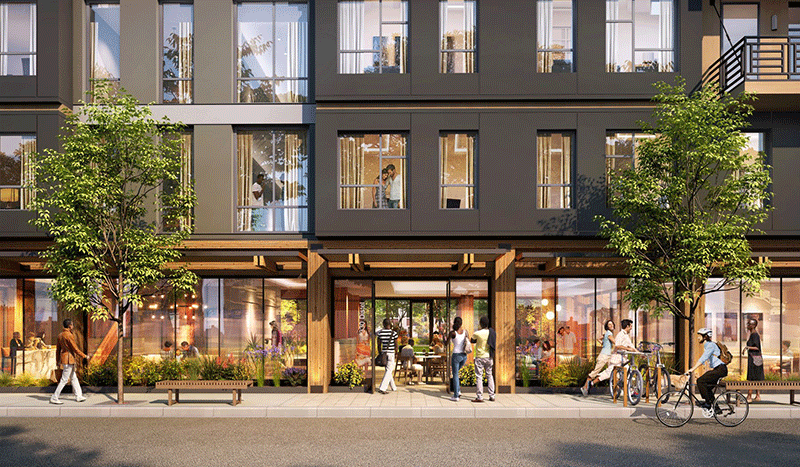 This article was produced by Mark Oberholzer and Zac Miles, associate principals at KTGY.
This article was produced by Mark Oberholzer and Zac Miles, associate principals at KTGY.
Visit here for valuable new data on mass timber design.
Of the five well-known construction types defined within the International Building Code, Type IV, commonly known as “heavy timber,” has been the least-used in the United States. New Type IV buildings have dwindled over time as large trees have become less available and more efficient construction systems have developed.
However, mass timber has emerged as a viable construction type because of two recent developments: an update to the International Building Code within Type IV Construction and a relatively recent large-scale investment in mass timber fabrication technologies and equipment. Building structural sheathing in Types III and V widely use plywood, a laminated sheet material. Now that same lamination method can work with larger structural members. Large-scale producers provide a reliable supply of mass timber structural members. This has allowed Type IV buildings to become more common.
Mass timber offers the commercial real estate industry three primary advantages: increased sustainability, great flexibility in adapting to different structural needs and building programs, and intriguing aesthetic opportunities. The following three projects illustrate the possibilities of this emerging construction type.
Mass Timber Stands in for Steel: Edes Building Gallery
On the main street in the historic downtown of Morgan Hill, California, this small two-story commercial art gallery would typically be designed with a steel structural frame. Instead, the designers used Cross-Laminated Timber (CLT) columns, beams and planks to create a flexible gallery that is a work of art in itself. In a counterpoint to most art galleries, the Edes Building Gallery isn’t a “white box,” but instead highlights the natural wood tones of the structure as a backdrop for a very personal approach to viewing art.

In a sense, this is mass timber in its most simple form–load transferring to the ground at column points in the same way a typical steel system works. In fact, the practical span limits of mass timber and steel are very similar: Efficient spans for a plank, beam and column system are between 20 and 30 feet.
There’s also a practical aspect to framing the roof with CLT–it easily adapts itself to the chamfered, tapered form of the roof without complicated framing. Breaking ground in the first quarter of 2022, the Edes Gallery will demonstrate how mass timber can offer an alternative to conventional structural systems. It may be possible that mass timber will become so widely adopted that in time it will itself be able to be called “conventional.”
Innovating in Three Building Systems: 330 Distel Circle
In the city of Los Altos, 330 Distel Circle is an affordable apartment building that rethinks how podiums can be built. The podium type building–wood construction over a concrete base–replaces the concrete podium with CLT panels supported by glulam beams and columns, creating biophilic common spaces that showcase mass timber’s natural finish.

Mass timber systems have inherently lower embodied energy than concrete or steel, with the added benefit of lower weight, which can help reduce the size of foundations. Substituting a mass timber base for a concrete podium also offers the intriguing possibility of making small, urban-infill projects more feasible since mobilizing construction for a small concrete podium is often prohibitively expensive.
Distel Circle uses an automatic parking system. It can be removed and replaced with other programming, such as additional units, when some or all of the parking is no longer needed. This adaptable approach allows for valuable flexibility and “future-proof” design. With car ownership on the decline and other modes of transportation rising, parking can adapt with the future of materials.

Above the mass timber base, the residential units are factory-built wood-frame modular. The modular units dramatically increase building delivery time and reduce disruption to surrounding neighbors. Like the mass timber elements, the modular units allow more work to be performed offsite, greatly increasing efficiency and sustainability.
Most of the building–timber members, mechanical parking and modular units– is produced in a factory where quality is tightly controlled and waste minimized.
Increasing Urban Sustainability: Mass Timber Tower Prototype
Although the Edes Gallery and Distel are very different types of buildings, both use a mass timber system of spanning CLT planks, beams and columns. In a somewhat different approach, KTGY’s prototypical Timber Tower eliminates the use of beams on residential levels of a 12-story building. This prototypical design takes advantage of the inherent flexibility of mass timber’s CLT planks that span between columns without beams. Because room sizes in typical residential units don’t need to be more than 13 feet wide, this eliminates the need for the extra building height.

Configuring the building as 12-stories allows the interiors to leave portions of the structure exposed, taking advantage of the aesthetic look and feel of natural wood inside residential units. With the allowable stories ranging to a maximum of 18 levels, this “short” high-rise building is an attractive alternative to either a wood “podium” type building (which is limited in height) or a concrete high-rise building (which is very expensive to build).

Concrete, while the most widely used construction material globally, includes both raw materials and manufacturing practices that produce a concerning amount of embodied carbon. Steel as a structural system also contributes significant embodied carbon; however, the amount varies widely depending on the manufacturing process and share of recycled content. As a renewable resource, wood construction is an effective alternative, with lower embodied carbon than many other materials, including concrete or steel. Recent manufacturing techniques – such as cross-laminated timber – produce superior structural members with remarkable acoustic, fire, seismic, thermal and spatial performance. Large-scale, offsite prefabrication of CLT contributes to greater design flexibility. And great efficiencies come from the use precision panel sizing, and incorporating window and door openings using mechanical measuring and cutting tools. These achieve outstanding levels of accuracy while minimizing on-site construction time and waste.
Now more than ever, residential construction responds sensitively to the challenges of climate change, as mass timber minimizes embodied carbon while succeeding with structural and fire-resistance goals. Along with associated code modifications, mass timber offers bright opportunities for green and enhanced well-being.
Learn more about Mass Timber construction innovation by contacting Jeremy Agraz, National Development Director.



